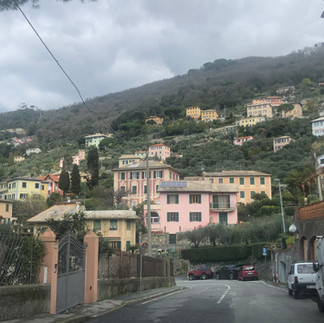Travel: Camogli 3/16/2024
- Lili Naveh
- Mar 16, 2024
- 4 min read
Updated: May 4, 2024
This post is a continuation of a trip North of Rome along the Western coast of Italy.
Civitavecchia -3/6-7 (part 1). Carrera. 3/12 (part 5)
Livorno. 3/9-10. (part 3)
Lucca. 3/11-12. (part 4)

Half an hour away from Portofino/ Rapallo is this quaint authentic fishing village attracting mainly local tourists

Departing Santa Margarita di Ligura


The drive from Santa Margarita and across the mountainous small peninsula presents views off the "Golfo Paradiso" (from Genoa to Monte di Portofino) which are absolutely stunning.
Colorful houses dots the the lush verdant alleviated landscape on one side, and the horizon-less spread of the bluish se-on the other

The "Golfo Paradiso" is best explored by following the ancient Via Aurelia road
traversing the whole of Liguria.
It starts in Nervi, a suburb of Genoa that is a true “middle ground” between the city and the Riviera. (will be mention in another post)
Bogliasco, an old sailor’s village with a Roman bridge that offers splendid views of the two banks of the Rio Poggio river.
Pieve Ligure, offers narrow creuze (road of steps), and aroma of mimosas, to which a local festival is dedicated.
Sori, the birthplace of Pablo Picasso’s ancestors,
Recco- a place to try traditional cheese focaccia.

And Camogli, -the undisputed pearl of the gulf.
Once the "City of a Thousand White Sailing Ships"
Camogli from top of the Mountain Road
This most charming an authentic seaside Ligurian village, which slops down into the Riviera's coastal shore, is characterized by highly-stacked and vivaciously-painted houses, rooted in a magnificent natural rocky setting

What makes this seaside village such a special place is its own beautiful panorama, its charming marina, surrounded by the colorful historic buildings close to the seafront and the ruins of the medieval castle along with the magnificent seaside promenade, full of typical restaurants and small B&Bs,
By the Beach Promenade

Attractive sea food restaurants, cafes, bars and trinkets' shops line the narrow promenade in front of the colorful chained buildings and the dark-sand beach strip.

The house colors once helped the fishermen of Camogli find the way back to their port.
Occasional Rock-Sliding into the sea reveals the caves under the upper surface

In 2021, a cliff collapsed below the cemetery that is sited 70m above the water, and coffins fell into the sea. 11 caskets were recovered from the water, and more from the landslide
The quint small harbor,

In the late Middle Ages, Camogli was a sizeable port city. The town’s fleet consisted of hundreds of big impressive ships in its heyday.
It was called the "City of a Thousand White Sailing Ships" and represented the third Italian power in the Mediterranean. In 1798, the city hosted a large contingent of Napoleon's fleet, which was then beaten in the Egyptian waters of the Nile by Admiral Nelson.
The prestigious naval college "Cristoforo Colombo" was founded in Camogli in 1874, named after the Genoese navigator, and it continues the glorious seafaring tradition.
In 1880, of Camoli’s then 12,000 inhabitants, 500 were patented sea captains.
Today , less than 6000 inhabist the village.
Also, a local small Gio Bono Ferrari Maritime Museum keeps the city’s nautical history alive memory of Camogli’s maritime traditions
It contains paintings, photographs, models, and documents donated by the Camogliesi families, a testimony of the ancient sailing ships that belonged to the owners of Camogli in the period between the Napoleonic wars and WWI.
A walk on the Pier along the Harbor

Among the noticeable sights is this church- the spiritual heartland symbol of Camogli

Basilica Minore di Santa Maria Assunta from 12c facing onto the port and features a double facade in the Ionic style. It stands on what is called the ancient medieval rock island, the fulcrum of the village, where the political and religious life of the hamlet was carried out in ancient times
The church can be reached from the small square off the nearby small quaint marina by climbing a wide grand staircase leading up.
The church's elegant facade simplicity is in sharp contrast to the opulent interior.
decorated in Baroque style with gilded stucco, polychrome marble, crystal chandeliers and colorful frescoes on the vaulted ceiling.
The building was consecrated in 1826 and in 1988 Pope John Paul II has raised to the rank of Minor Basilica.
The colorful alleys and buildings close by the church
A special feature of the entire Ligurian region are the brightly painted house facades. Their decorations, known as trompe l’oeil, represent architectural realistic elements such as pedestals, ledges, balconies, flowers, or closed shutters.
The Fortress/Castle
Right behind the Basilica is the medieval depleted Dragonara Castle, a fortress that was built in the 13c, to protect the village and the coast.
The popular definition deriving from the term "Dragonaria" meaning "vortex of storm air" indicates the particular position overlooking the sea often exposed to heavy seas and storms, The fortress built as a watchtower to defend the ancient hamlet and the surrounding stretch of coast-liine from the raids of Saracen pirates, has a terrace with a very picturesque view of the sea and the village.

This originally-maritime and commercial locality has developed strong artisanal activity over the course of time, particularly yarn-spinning, weaving and textile-dying, as well as ceramic Fish handicrafts, had replaced the trade and seafaring.
Today, Camogli’s main source of income is, obviously, tourism.

The Handcrafts stands at the harbor
full of Fish Art


The name of the town Camgoli is ancient and story about its origin suggests it comes from the shortened Casa de Moglie. When the ship captains sailed off they placed their wives (mogli) in a collective sort of home and the town was well known for this.

Bye Bye Camgoli

To be Continued.....























































































Comments